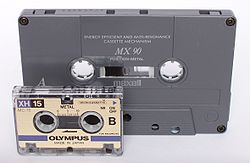Microcassette: Difference between revisions
No edit summary |
|||
| Line 33: | Line 33: | ||
*In the TV series and toy line [[The Transformers (TV series)|The Transformers]], the [[Decepticon]] [[Soundwave (Transformers)|Soundwave]] transforms into a Microcassete recorder. Between 1984 and 1988, as many as 10 Decepticons and 6 [[Autobot|Autobots]] were made to disguise themselves as microcasettes, plus an additional 4 Autobots exclusive to Japan. |
*In the TV series and toy line [[The Transformers (TV series)|The Transformers]], the [[Decepticon]] [[Soundwave (Transformers)|Soundwave]] transforms into a Microcassete recorder. Between 1984 and 1988, as many as 10 Decepticons and 6 [[Autobot|Autobots]] were made to disguise themselves as microcasettes, plus an additional 4 Autobots exclusive to Japan. |
||
*In the [[Stanley Kubrick]] film [[A Clockwork Orange]], Alex listens to a microcassette of [[Beethoven's Ninth]] on his home stereo system. When the film was released in 1971, getting such high fidelity out of such a tiny tape was |
*In the [[Stanley Kubrick]] film [[A Clockwork Orange]], Alex listens to a microcassette of [[Beethoven's Ninth]] on his home stereo system. When the film was released in 1971, getting such high fidelity out of such a tiny tape was [[science fiction]]. |
||
==External links and references== |
==External links and references== |
||
Revision as of 16:59, 17 January 2008
| File:MicrocassetteLogo.jpg | |
 A Microcassette is significantly smaller than a Compact Cassette | |
| Media type | Magnetic tape |
|---|---|
| Encoding | Analog signal |
| Capacity | MC60 (30 min per side at 2.4 cm/s) MC15 MC30 MC90 |
| Read mechanism | Tape head |
| Write mechanism | Magnetic recording head |
| Developed by | Olympus |
| Usage | Dictation, audio storage |
A Microcassette (often written generically as microcassette) is an audio storage medium introduced by Olympus in 1969. It uses the same width of magnetic tape as the Compact Cassette but in a much smaller container. By using thinner tape and half or a quarter the tape speed, microcassettes can offer comparable recording time to the compact cassette. The original standard microcassette, the MC60, gives 30 minutes recording per side at its standard speed of 2.4 cm/s, and double that duration at 1.2 cm/s. Unlike the Compact Cassette, a choice of recording speeds was provided on the original recorders and many others; the tape also spools in the opposite direction, from right to left. For transcription purposes, continuously variable speed was provided on many players.

Microcassettes have mostly been used for recording voice. In particular, it is commonly used in dictation machines and answering machines. However, it has also been used as a medium for computer data storage, and as a medium for recording music. For the latter purpose, devices for recording microcassettes in stereo were produced in 1982 and, for higher fidelity, microcassettes using metal tape were sold. This was an attempt by Olympus to cash in on the burgeoning Walkman market, but the limited fidelity and high price of the equipment meant that these units were phased out within 24 months. One model, the Olympus SR-11 even had a built-in FM tuner, and a stereo tie-clip microphone was sold as an accessory for it, which was popular with concert-goers who would record the concerts.
Comparable products to the microcassette include the minicassette, produced by Philips, and the picocassette, produced by Dictaphone. Of the three formats, the microcassette was the most common. In 1992, Sony released the NT memo recording system which employs a small cassette, but records digitally.
See also inches per second and audio tape length and thickness for comparisons with other media.
Trivia
- In the Saw film Series, Jigsaw and his apprentice Amanda use these audio tapes to deliver messages to their test subjects.
- In the TV series and toy line The Transformers, the Decepticon Soundwave transforms into a Microcassete recorder. Between 1984 and 1988, as many as 10 Decepticons and 6 Autobots were made to disguise themselves as microcasettes, plus an additional 4 Autobots exclusive to Japan.
- In the Stanley Kubrick film A Clockwork Orange, Alex listens to a microcassette of Beethoven's Ninth on his home stereo system. When the film was released in 1971, getting such high fidelity out of such a tiny tape was science fiction.
